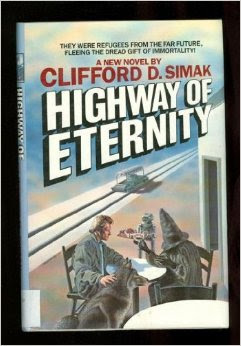Forgotten SF: Clifford D. Simak's Highway of Eternity
.

Important writer though he was, Clifford Simak's novels grew looser and more shambolic as he aged. Highway of Eternity, a book I read recently because it was at hand and I was too sick for anything more serious, is a good example of this. A family of fugitives is hiding in a bubble of time in the Thirteenth Century. They are refugees from One Million Years in the Future. And their names...?
They are David, Emma, Horace, Timothy and Enid. The Evans family. Surprisingly little changes in the next million years, apparently
The plot is a rambling, arbitrary mess. Multiple suspensions of disbelief are required to keep it going. The implications of the enabling technologies are pretty much ignored. Stucturally, Highway of Eternity is a hot mess.
And yet... There are two good bits in it. One comes after Boone, the protagonist, kills an assassin-bot in pre-human North America. As he is surveying the wreckage:
And later another character, Corcoran, in the far future sees something unexpected:
Both those moments evoke that most hoary of science fiction virtues -- the sense of wonder. A little of which can make up for a great deal of what otherwise was a terrible waste of time.
Beginning writers should take note.
*

Important writer though he was, Clifford Simak's novels grew looser and more shambolic as he aged. Highway of Eternity, a book I read recently because it was at hand and I was too sick for anything more serious, is a good example of this. A family of fugitives is hiding in a bubble of time in the Thirteenth Century. They are refugees from One Million Years in the Future. And their names...?
They are David, Emma, Horace, Timothy and Enid. The Evans family. Surprisingly little changes in the next million years, apparently
The plot is a rambling, arbitrary mess. Multiple suspensions of disbelief are required to keep it going. The implications of the enabling technologies are pretty much ignored. Stucturally, Highway of Eternity is a hot mess.
And yet... There are two good bits in it. One comes after Boone, the protagonist, kills an assassin-bot in pre-human North America. As he is surveying the wreckage:
The monster spoke inside his mind.
Mercy, it said.
"The hell with you," said Boone, speaking before astonishment could dry up his speech.
Don't leave me here, the monster pleaded. Not in this wilderness. I did no more than my job. I am a simple robot. I have no basic evil in me.
And later another character, Corcoran, in the far future sees something unexpected:
There was a strangeness about the ridge top -- a faint haziness (...) He slowed his walking, came to a halt, and stood staring up at the haziness that was beginning to assume the form of a gigantic, circular, free-standing staircase winding up the sky.
Then he saw that he was wrong. The staircase was not free-standing; it wound around a massive tree trunk. And the tree -- good God, the tree! The haziness was going away and he could see it more clearly now. The tree thrust upward from the ridge top, soaring far into the sky, not topping out, but continuing upward as far as he could see, the staircase winding round it, going up and up until the tree trunk and the staircase became one thin pencil line, then vanished in the blue.
Both those moments evoke that most hoary of science fiction virtues -- the sense of wonder. A little of which can make up for a great deal of what otherwise was a terrible waste of time.
Beginning writers should take note.
*
Published on December 19, 2016 09:21
No comments have been added yet.
Michael Swanwick's Blog
- Michael Swanwick's profile
- 546 followers
Michael Swanwick isn't a Goodreads Author
(yet),
but they
do have a blog,
so here are some recent posts imported from
their feed.



